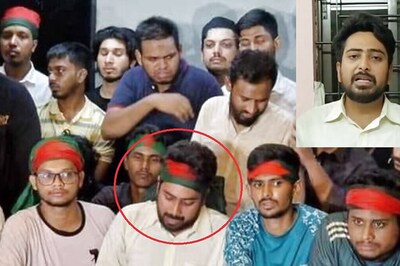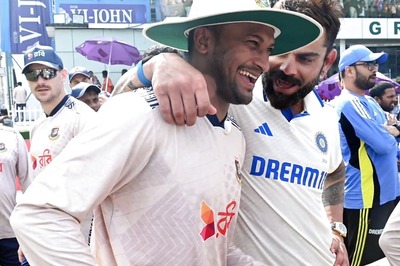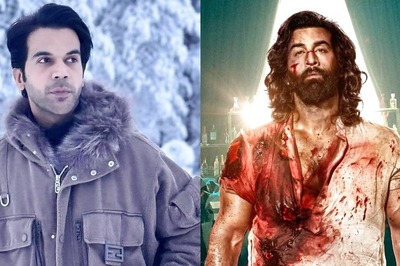
views
We are now loosened from the gravity of identity’s land. What will we do… what will we do without exile — Mahmoud Darwish
As 2017 slowly and boringly fades into the thick folds of history, Salman Khan is riding a tiger and Prime Minister Modi is riding a Metro. Still enjoying a purple patch, he opens the magenta line that connects the lugubrious heart of Lutyens Delhi with one of its many fast-growing limbs, Noida. It’s a driverless train. A perfect photo-op for the Prime Minister. Driving the nation and its billions towards a bulkily shining trillion future, he can fancy himself a train driver too. He embodies the sarkar and he is taking it into the suburbs, if not the exurbs. Salman’s box office is burning bright and so is Modi’s, especially after those victories in Gujarat, where he slayed the newly energetic Congress dragon, and Himachal, where the sun-dappled hills sang only his name. Salman, through his beautiful bride, conciliates with Pakistan and still makes bank. Modi could perhaps do that next year or wait for Salman to ride his third tiger with his kids, a joint Indo-Pakistani production, doing a Dabangg dance on their own OBOR.
Modi also attended the wedding jamboree of Anushka Sharma, the actor, and Virat Kohli, the Indian cricket captain and, like Salman, prodigious record-breaker. Rab ne Bana de Jodi, he would have told the bearded skipper. By next yearend, he too would be looking for perfect Jodis for his party for Mission 2019. And Virat, of course, came dancing all the way from the pitch, after thrashing Lanka, to the marital pavilion and did bhangra with Gurdas Mann. That, shaking a leg after beating Lanka, too would have made Modi happier because diplomatically he hasn’t been able to score a win in Lanka, which continues to flirt with O-BORe China.
Was 2017 the year of the Indian elephant? The markets, vaulting like Sergey Bubka, may say yes; Moody’s, the rater whose mood swings no one can divine, may too nod in agreement; the economy, because it didn’t get to flex its thunder thighs like Silk Smitha, may be ambivalent; the saffroniks, now running like Usain Bolt into all the nooks and crannies of this ancient nation, may say a vigorous, thumping, screaming yes. But there are many ants among these Indian elephants. Sujatha Gidla, in her seminal and searing book Ants Among Elephants, writes in microscopic detail about human exploitation and societal degradation. How humans can be so nasty and brutish towards other humans; how sneering upper castes can look with utter disregard towards lower castes; how education, that Indian vehicle to reach higher stations in life, can be totally dominated by English-speaking elites; how old prejudices keep living on refusing to die; how caste chips away at confidence. As the Indian elephant aspires to straddle the world, these ants still exist and are marching relentlessly in their corners of the country.
Growth, unlike the Bengalis, still doesn’t travel much in India. Neon-lit growth is monopolised by city-bred and mall-fed Indians. The ants aren’t dying; they are only multiplying. And marching. And stridently marching. Agriculture is dying; farmers too are dying of their own impoverished, debt-tied hands; infrastructure remains a specter no one sees in the Indian countryside. As the Indian elephant marches on, so do the puny ants, almost in lockstep.
Across seas, the dogged march of the migrants continues, worrying many nativists and nationalists. President Trump gets up before first light and spreads darkness through his Twitter storms; the alt-right, in their KKK or some different avatar, goes stomping with its tiki torches. The likes of Steve Bannon, with their hate and hoaxes, keep the American cauldron boiling. Black jocks, protesting police brutality and growing racism, take the knee and Trump punches his angry anthems on Twitter. America also saw a devastating hurricane. The #MeToo hurricane, which brought down to earth many skyscraping careers. Women spoke, and spoke truth to power. And they spoke hard and without fear. It’s not the position, but the disposition, said Susan Sontag. The truth, she said, is always something that is told, not something that is known.
In Europe, the baseless fear of Eurabia persists, hanging like a darkening cloud over the continent, which is now a limping economy fed by the IV of malicious rumours. At least Jean Raspail is happy. His book The Camp of the Saints, now considered scripture for the Right, is being devoured after many years. Bannon swears by it; Le Pen exhorts her followers to read it. In early 70s, Raspail, who is now hailed as the intellectual forefather of alt-right, wrote about France being overrun by emaciated, luckless Asiatics. And before we start gloating and say Muslims with unhidden glee, note that Raspail wrote about “fleshless Gandhi-arms” descending on France’s shores. An army of almost a million skinny Hindus, riding boats full of “scraggy branches, brown and black” decides to make France its home. “The Third World had started to overflow its banks,” writes Raspail, “and the West was its sewer.”
So, in Europe, as Muslim refugees flee from war, terrorism and other humiliations, many now think the continent is becoming a putrid sewer for the Third World. Gotz Kubitschek, the prophet of Germany’s New Right, would also make the same assessment. The ants are crawling all over the European elephant. Loosened from the gravity of their identity’s land, the migrants look for exile. But it is hard to come by. History, even when it is boring and dull, makes it difficult for the exiled. Physical borders may be easier to cross, but the borders of faith and fraternity are difficult to overcome. History, said Tony Judt, always happens to us and nothing ever stays the same. Perhaps things may change; perhaps history may happen to these hapless refugees. Perhaps Europe may start believing what Ariel Dorfman said: we live in the age of the refugee, the age of the exile.
Even in this age of the selfie and snapchat, some leaders, so strongly they grip the coattails of power, stare sullenly at you like ancient black-and-white photographs. When memories and chats erase within minutes, nothing can stay forever. Yesterday is just a memory, said Bob Dylan, tomorrow is never what it’s supposed to be. The tomorrows of politicians such as Zuma and Mugabe changed; their nations and peoples just decided to shove aside their hideous memories. But some jefes hung on, plunging their fates and their nations’ headlong into the abyss. Maduro kept doing the rumba as his people suffered helplessly; Kim, like a brat gone astray, played with new and dangerous toys every day and shot rockets everywhere, keeping the world on edge. The whole year he was madder than that kooky and cranky general in Kubrick’s Dr Strangelove.
The world stayed crotchety and unequal. Fake news extended its suzerainty through Facebook and Twitter warriors. Social media, with its confusion and craziness, became the new heart of darkness. But no Conrad emerged to take us through the treacherous, imperiled journey to the other side. Towards peace and calm, towards sanity and sobriety. In India, Mamata, swatting opponents, went after mosquitoes and rightwing weirdos, always looking for a new bugbear to seek TV time and publicity, raged about Padmavati, a fictional queen Bhansali venerated on cellullid in Bollywood’s dreary dream factory. Myth, said Thomas Mann, is the foundation of life, but a life lived amid hoaxes and fake news and 24x7 smartphone slavery creates and destroys millions of myths every day. There is no time to build a foundation. We all are furiously writing history, but it is kind only to a few.
As a year closes, it is better to believe in what Thomas Jefferson said: I like the dreams of the future better than the history of the past. Yes, even when the world is on a slow burn. Tiger Zinda Hai and the Indian elephant majestically rides the Magenta Line. Let’s do a Jimikki Kammal and wow the world. And as 2018 rolls in, we can sing, in Santhal Pargana if not in Santorini: swag se karenge iska swagat.



















Comments
0 comment